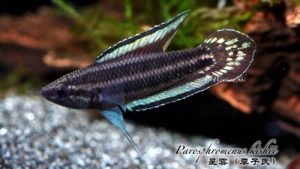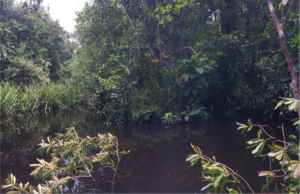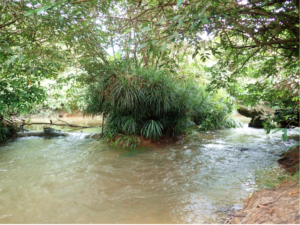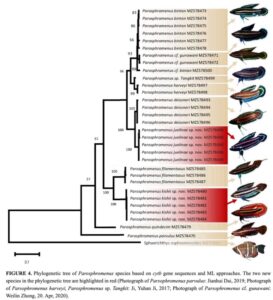October 28 2021 the article describing two new species from Indonesia was published by our team scientist and field work manager Wentian Shi, together with his team Shujie Guo, Haryono Haryono, Yijang Hong and Wanchang Zhang. The article was published in the journal Zootaxa and can be found here
Parosphromenus juelinae

- juelinae occurs on the island of Bangka, which also is where P. deissneri and P. bintan occurs, though not in same locations.
Its unpaired fin coloration is similar to that of P. deissneri, but it differs from the latter in having a rounded caudal fin with a non-filamentous branched median ray and a smaller anal fin. Although the new species has the same caudal fin structure as P. bintan, it can be distinguished from the latter by its distinct unpaired fin coloration and the intense red color on the body flanks
This species is restricted to a few adjoining forest streams and swamps belonging to the same river system in Bangka, which are not connected with the habitats of P. bintan and P deissneri. The habitats are well–preserved and relatively undisturbed by human activities. However, the edge of the distribution area of this species is now under growing pressure from agricultural activities. The swamp of the above-mentioned collection location in 2017 has been drained and converted into a paddy field in 2019; thus, likely extirpating the population.
Parosphromenus kishii sp. nov. can be easily distinguished from all other Parosphromenus by its unique reddish caudal fin with an irregular faint turquoise pattern and pointed rhombic shape.
 Parosphromenus kishii sp. nov.is confined to a single river, which now functions as a natural irrigation canal for a large oil-palm plantation. The habitat is extremely impacted. Any further works at the plantation may lead to dredging and expansion of this river, which may eradicate the only known population of this species. Thus, following the IUCN Red List Categories and Criteria (ver. 3.1), we propose that this species be listed as Critically Endangered B2ab (iii, v), based on its very restricted distribution within a single river running through an oil-palm plantation (<50 km2) with only a single known location and the extremely high likelihood of becoming extinct due to the potential works of surrounding oil-palm plantations. Immediate in-situ or ex-situ conservation is highly recommended for this species.
Parosphromenus kishii sp. nov.is confined to a single river, which now functions as a natural irrigation canal for a large oil-palm plantation. The habitat is extremely impacted. Any further works at the plantation may lead to dredging and expansion of this river, which may eradicate the only known population of this species. Thus, following the IUCN Red List Categories and Criteria (ver. 3.1), we propose that this species be listed as Critically Endangered B2ab (iii, v), based on its very restricted distribution within a single river running through an oil-palm plantation (<50 km2) with only a single known location and the extremely high likelihood of becoming extinct due to the potential works of surrounding oil-palm plantations. Immediate in-situ or ex-situ conservation is highly recommended for this species.




